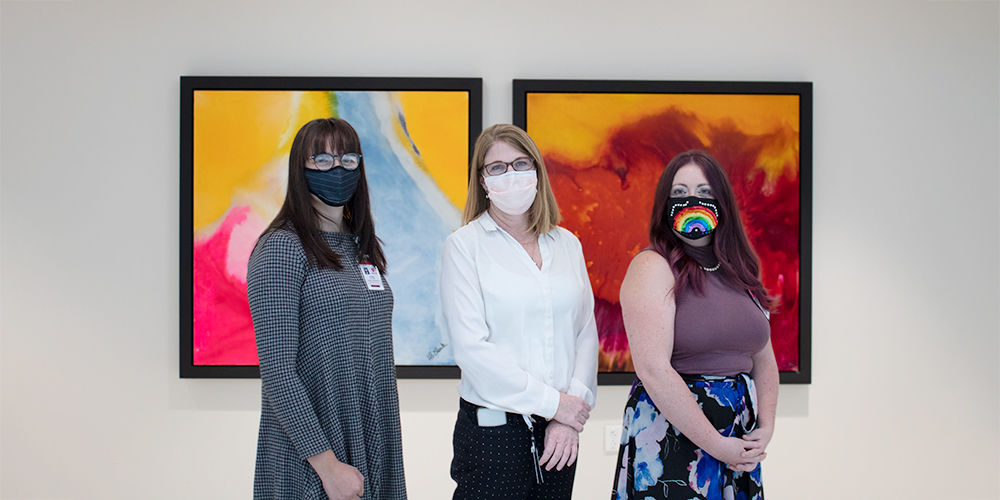lot of major decisions in my [Cori] life have happened by lucky circumstances and serendipity, including developing expertise in transgender care. I didn’t know I wanted to be a physician when I was young, but knew I wanted to help people so becoming a physician made sense and ended up being a great choice for me. In medical school, I enjoyed working with my hands fixing things so surgery seemed to be the obvious choice. Within surgery, I chose plastic surgery because it is more of an art and allows you to be creative in solving problems. I never once took care of a transgender person throughout medical school, residency, or fellowship. Even today, there is very little formal medical training around transgender health.
What is Grit?
Resilient and hard-working with deep conviction. A combination of passion and perseverance. Determination with direction. Our people—our physicians, our nurses, our custodians, our medical assistants, our leaders—embody grit every day.
Developing transgender care due to patients’ needs
About 12 years ago and a year or two after I came to the University of Utah, a patient asked if I could help create a masculine chest for them. I needed to do some research including learning about the patient’s goals, reviewing the literature, and talking to other surgeons, but ultimately ended up doing my first chest surgery. The patient did well and referred more patients to me, and since then, that portion of my practice has grown because of word of mouth and good outcomes. It became clear, however, that we needed to provide comprehensive care for this population and we were not set up in a way that could easily deliver it.
Over the next several years, I gradually started making connections with other providers who were also passionate about caring for transgender patients. I met the physicians who were providing hormones, the adolescent doctors, and the mental health therapists. We started having casual meetings and making connections so that we could refer patients for the care they needed.
It took several years of these informal meetings before we were able to formalize our vision and advocate for a multidisciplinary Transgender Health Program. We knew we needed a program to address an issue central to transgender people: avoidance of health care. Transgender and gender non-binary individuals are known to avoid medical care, in part due to fear of discrimination and in part due to lack of universal provider training and a history of suboptimal or even unsafe medical care.
Transgender individuals disproportionately experience mental health issues including depression, anxiety, and self-harm, and it is especially important that they are able to find the care that they need. They need an environment where they trust that everyone they see, from the receptionist all the way to the provider, will ensure their safety and provide quality care.
Transgender individuals disproportionately experience mental health issues including depression, anxiety, and self-harm, and it is especially important that they are able to find the care that they need.
The interconnectedness of specialties is essential to creating a successful transgender health program. There is a lot of interplay between hormone timing, mental health, testing and screenings, and surgery and fertility discussions. The providers need to be connected. When considering the complexity of care for the transgender population, you quickly realize it has to be a team approach. Creating a multidisciplinary program at the University was not an easy task, but ultimately, U of U Health has been very supportive.
How the Transgender Health Program works
We are lucky to have an excellent group of providers that engage in collaboration. We now have over 30 providers in the group, 10 of whom are part of the Core Leadership group. Because formal training programs are sparse, we rely on each other for clinical knowledge sharing. The Core group meets monthly to discuss patient care, outreach, and program goals. Additionally, we have two administrators, Ariel Malan and Claire Cullinane, who help with outreach, program growth, and patient navigation through their care.
Our Transgender Health Program works as a team by:
-
Staying connected. We rely on our Patient Coordinator to arrange appointments and keep us informed. We also regularly share our notes to the team on Epic after each visit.
-
Meeting regularly. We hold a series of regular meetings, including our monthly meetings with separate programs, monthly core meetings, multi-disciplinary discussions, and quarterly and biannual meetings. These give us a chance to stay up-to-date with all the different aspects of patient care.
-
Adding new providers to the group. As our patient population grows, so must our team. We vet new providers by making sure they meet certain standards of training. We encourage them to become members of the World Professional’s Association for Transgender Health (WPATH). We ensure that each provider who cares for transgender patients as a part of their practice delivers high quality and compassionate care.
-
Leaning on each other’s expertise. We each bring to the table a different set of knowledge and skills from our training and new information that is always emerging and shared through national meetings and in the literature. We play to our strengths and lean on each other when we have questions.
Ultimately, we want trans patients to know that they will receive knowledgeable, safe care, and that the provider will know who to reach out to if they don’t the answer to a particular question.

Best Practices for Transgender and Gender Diverse Patients
by Ariel Malan and Andy Rivera, Accelerate University of Utah Health (2020)
The future of transgender care
We've come a long way from the days when we were caring for transgender patients in a silo. The Transgender Health Program has allowed us to coordinate our care and therefore be better providers. We have a lot of ideas for improving and growing the program, and a lot of these come from our patients who give us feedback every day.
Health care improvement. As health care professionals, we think we know what’s best, but we need to design care with patients, not just for patients. We rely on their feedback to make sure our efforts to improve are guided in the right direction. We recently implemented a Patient Advisory Board to ensure that as we move forward, we are connected with the needs and ideas of the LGBTQ+ community. So many of our past patients want to be a part of helping us grow our program; it’s been amazing to witness this infusion of energy and new ideas.
As health care professionals, we think we know what’s best, but we need to design care with patients, not just for patients.
Research and Teaching. We’re also focusing on research and provider education. I don’t want the next generation of medical students and residents to find themselves in my shoes, where they have to learn everything on their own. We want to improve ourselves every single day, even if we’re just tweaking an element of a procedure or introducing the importance of LGBTQ+ friendly language. Educating our medical students, nursing students, pharmacy students, physician assistant students and—more broadly—our practitioners, will help establish an underlying culture of sensitivity when taking care of a gender diverse patient. We have been actively working on adding trans specific education to the curriculums and have started an elective for medical students. We have hosted educational meetings for providers and all learners to teach trans specific health care.
Foster relationships. Above all else, we’re working to empower our patients by encouraging open communication about preferred gender, pronouns, and names institution wide. We have been working on improving EPIC to better reflect these simple identifiers and have been providing education to various departments and staff groups to teach best practices for trans health. Addressing people correctly is so simple, it takes the tiniest amount of effort, and it can instantly alleviate a patient’s anxiety.
Measure to manage. A number of our core team members are engaged in research to study and improve various aspects of transgender health. In addition to data on health and surgical outcomes, we need to locate gaps within racial and ethnic minorities that we serve and age groups that we’re missing so we can target those communities and become more accessible.
Talk about it. Finally, we need to spread awareness of the LGBTQ+ community and support political advocacy for better care. We need to spread the message that the changes we’re fighting for are safe, good, and absolutely necessary.
Health Equity Index Top Performer Designation
The University of Utah Health received the LGBTQ Health Care Equality Top Performer designation from the Human Rights Campaign Foundation (HRC). This award showcases the immense strides U of U Health has taken to nurture a safe, welcoming environment for all patients. Their focus on top quality, whole-patient care sets them apart as leaders in the industry.
HRC also commends the institutions that participated in the HEI survey for their unparalleled response to the tragedies that have swept across the nation this year. Their ceaseless work to combat the devastation of COVID-19 despite limited supplies, overcapacity and reduced workers has been inspiring. Also, HEI participants’ resounding denouncement of systemic racism, and their implementation of new programs that address racial disparities remind us to stand together.
We'd like to give a special thanks to RyLee Curtis, director of community engagement for U of U Health, who played an instrumental role in obtaining the HEI Top Performer designation.
Ariel Malan
Cori Agarwal
Transgender and gender diverse patients face systemic discrimination in our broader society and inequitable access to needed care. Ariel Malan, program coordinator and Andy Rivera, volunteer for Utah’s Transgender Health Program, share how to create an inclusive care environment for this vulnerable population focused on trust and respect.
As Redwood Health Center’s program coordinator serving new Americans, Anna Gallegos has learned valuable lessons that can help all of us better care for patients of refugee background and vulnerable populations. Here are three suggestions to help make caring for patients easier.
The crises of Covid-19 and police brutality have highlighted systemic racial inequity in the United States and the need to consciously dismantle the forces that cause racial health disparities. PA students Scarlett Reyes and Jocelyn Cortez brought together Black patients at the University of Utah to share their experiences. Their advice: build cultural competence and be mindful of microaggressions.
